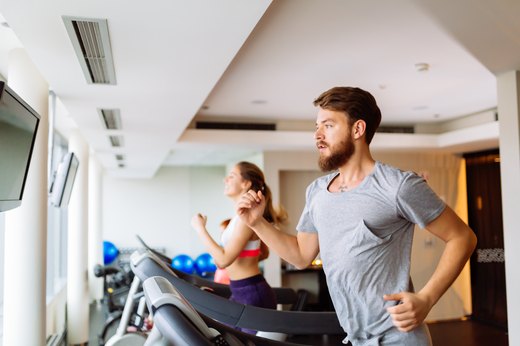https://www.livestrong.com/slideshow/13709833-9-warmup-and-cooldown-mistakes-wrecking-your-workout/
Warmups and cool-downs are the glue of your workouts. Done correctly, warming up and cooling down may help reduce the risk of injury, improve athletic performance and increase desired fitness results. Even though it takes just a few extra minutes, it’s easy to fall into the habit of not warming up or cooling down properly. So the next time you block off 60 minutes for a workout, try a 10-minute warmup, 40-minute workout and a 10-minute cool-down, keeping the following tips in mind. You’ll be giving your body the best chance to stay healthy and free of injury.
1 Skipping Your Warmup
Avoiding your warmup altogether may be tempting, especially if you’re trying to save time. But that can do more harm than good. A good warmup focuses on range-of-motion exercises, active movement and balance activities that will effectively prep your body for working out. Such activities raise your heart rate safely, pump more nutrient-rich oxygenated blood to your muscles and gradually raise your core body temperature. They also prevent injury during workouts and ensure the utmost safety for your sweat session. The key is to defrost yourself before your pedal-to-the-metal workouts and start warming up!
Read more: 10 Dynamic Warmup Exercises to Prime You for Your Workout
2 Starting Off With Too Much Intensity
Slow and steady wins the race! A solid warmup should essentially mimic what you plan on doing in the main portion of your workout, but at a much lighter and gentler pace. Going full-throttle without warm muscles can cause serious injuries — like a muscle strain or even a tear — and that’s the last thing anyone wants. Think of your warmup as your workout in slow motion or at a lower intensity. So if you’re planning on doing a lot of squats, deadlifts and lunges (sounds like leg day), make sure you do dynamic stretches that target the hips, quads, hamstrings and the rest of your lower body.
3 Doing Static Stretches First
Stretching is vital when it comes to working out, but only when it’s the right kind of stretching! Applying static stretches (holding a stretch for 30 seconds or more) during a warmup has been shown to actually be detrimental to athletic performance. In fact, a 2013 Scandinavian review found that static stretches can reduce muscle strength by nearly 5.5 percent (or more when a stretch is held even longer), can cut muscle power by 2 percent and reduce power by nearly 3 percent. So make sure your preworkout stretches are dynamic (involve movement).
4 Not Warming Up Long Enough
Most of us have been guilty of it at some point: two minutes on the treadmill and we’re done with our warmup! But the American Heart Association says that an effective warmup should last between five and 10 minutes. The more intense the activity, the longer you should warm up. Your muscles need adequate time to circulate the blood, loosen up and prepare for the intensity to come. A great way to know if you’ve completed a long-enough warmup is to use a timer and give yourself enough time to break a slight sweat and raise your respiration rate.
5 Performing the Same Warmup for Every Workout
Unless you’re doing the same workout day in and day out, your warmups are going to need some adjusting! You’re targeting different muscles with each workout, so focusing on your upper body, lower body or full body all require a specific routine. And sports require specific warmup routines as well. For example, a simple walk on the treadmill for five minutes won’t cut it when you’re working your upper body. You need to warm up the muscles you’ll be using, even if that means all of them! Dynamic movements that go through a full range of motion combined with some light cardio will help achieve optimal workout success!
6 Not Cooling Down Afterward
Although you may save time, you aren’t doing your body any favors by forgoing your cool-down. An abrupt halt immediately after your workout harms your muscles as well as your heart. During an intense workout, your body goes through a number of stressful processes that involve muscle fibers, tendons and ligaments getting damaged just enough to grow back stronger. Additionally, waste products like lactic acid build up within your body. Avoiding a cool-down can increase soreness (called DOMS, or delayed-onset muscle soreness) and even result in blood pooling. But a proper cooldown prompts your body to begin its repair process.
7 Stopping Your Workout Suddenly
The main goal of a cooldown is to lower your core temperature and heart rate and to start preparing your muscles for recovery. But that’s harder to do if you immediately plunk down on the mat for some stretches or ride the feel-good hormones and keep going at a vigorous pace. Lowering your intensity gradually is the best way to cool down and end your session. For example, if you’re running, take it to a jog, then brisk walk, then slower walk. This gradual decrease in intensity will help calm the mind and should be included in every cooldown.
8 Not Stretching Properly
Muscle soreness is one of the most popular reasons people skip their workouts. One way to lessen the soreness is to stretch for the right amount of time after working out. During a workout, lactic acid builds up in the muscles, often leading to muscle soreness, stiffness and fatigue. This is where static stretching comes in. Warm muscles are ideal for a static-hold stretch. You should aim to do three rounds of 30 seconds per muscle group you trained. Remember, stretching should never be painful. If you feel any pain at all, stop and talk to a qualified professional like a doctor or physical therapist who can assess the situation better.
9 Not Using a Foam Roller
If you haven’t given foam rolling a try yet, there’s no better time to start! A 2015 study from Memorial University in Newfoundland found that it not only increases joint range of motion, but also reduces muscle soreness and speeds muscle recovery. Even better news: Foam rollers are inexpensive and can be purchased online or in most sporting goods stores. One thing to consider when getting a foam roller is density. Medium-density foam rollers will be less painful and offer less compression, while high-density ones will get deeper into the tissue, but will potentially be more uncomfortable.
What Do YOU Think?
Do you always include a warmup and cooldown in your workout? Do you make any of these mistakes? Were you aware you were making them? Are there any other mistakes you’ve seen people making before and after their workout? Share your stories, suggestions and questions in the comments below!



